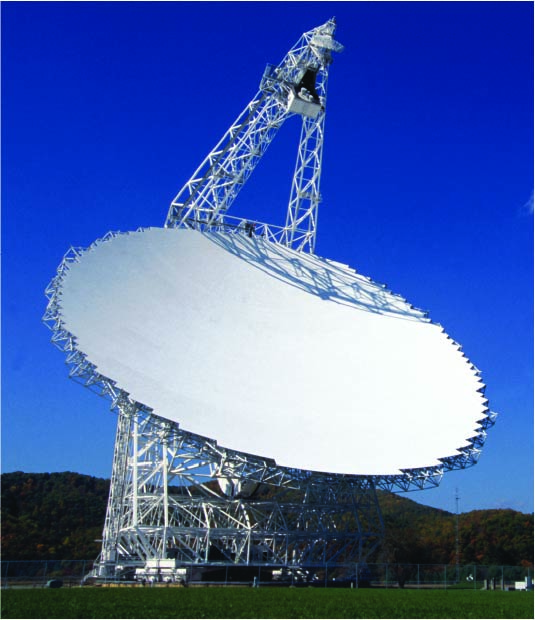AME and Axion Searches
Overview
We are currently working on two observing projects at the Green Bank Telescope.
Anomalous microwave emission (AME) refers to flux observed at mm and cm wavelengths that is not explained by free-free, synchrotron, or thermal dust emission. There is growing evidence that AME is produced by electric dipole radiation from spinning dust grains, and theory predicts that spinning-dust signal could be partially polarized. If observations show that AME from spinning dust is in fact partially polarized, then spinning dust will become an additional Galactic foreground signal that must be carefully considered in our ongoing and future CMB polarization studies. Concern about the possible impact spinning dust signal has on CMB B-mode searches is driving our interest in spinning dust studies.
The Peccei-Quinn (PQ) mechanism for solving the strong charge-parity (CP) problem in particle physics predicts the existence of a heretofore undetected particle, the axion. Light axions may be classified as dark matter (DM) because they behave cosmologically (on large scales) like a pressure-less non-interacting fluid, with lifetimes that can greatly exceed the age of the universe. The axion does, however, have unavoidable feeble interactions with the known particles; the most notable being the axion-photon coupling, which allows axions to convert into photons in the presence of a magnetic field. For non-relativistic axions (as in the case of axion DM), the energy of the photon generated in the aforementioned processes is given by the axion mass ( via E = m c2 ), and the photon production rate (in watts or photons/sec) is proportional to the square of the magnetic field — a process which can also be resonantly enhanced in the presence of an ambient plasma. Idealized axion searches thus require (i) strong magnetic fields, (ii) large DM densities in order to generate a sizable photon flux, and (iii) an instrument capable of measuring both the brightness and the frequency of any emerging photons. We are using the VEGAS spectrometer on the GBT to search for axions being converted to microwave photons in the magnetospheres of neutron stars at the center of Andromeda.
Anomalous microwave emission (AME) refers to flux observed at mm and cm wavelengths that is not explained by free-free, synchrotron, or thermal dust emission. There is growing evidence that AME is produced by electric dipole radiation from spinning dust grains, and theory predicts that spinning-dust signal could be partially polarized. If observations show that AME from spinning dust is in fact partially polarized, then spinning dust will become an additional Galactic foreground signal that must be carefully considered in our ongoing and future CMB polarization studies. Concern about the possible impact spinning dust signal has on CMB B-mode searches is driving our interest in spinning dust studies.
The Peccei-Quinn (PQ) mechanism for solving the strong charge-parity (CP) problem in particle physics predicts the existence of a heretofore undetected particle, the axion. Light axions may be classified as dark matter (DM) because they behave cosmologically (on large scales) like a pressure-less non-interacting fluid, with lifetimes that can greatly exceed the age of the universe. The axion does, however, have unavoidable feeble interactions with the known particles; the most notable being the axion-photon coupling, which allows axions to convert into photons in the presence of a magnetic field. For non-relativistic axions (as in the case of axion DM), the energy of the photon generated in the aforementioned processes is given by the axion mass ( via E = m c2 ), and the photon production rate (in watts or photons/sec) is proportional to the square of the magnetic field — a process which can also be resonantly enhanced in the presence of an ambient plasma. Idealized axion searches thus require (i) strong magnetic fields, (ii) large DM densities in order to generate a sizable photon flux, and (iii) an instrument capable of measuring both the brightness and the frequency of any emerging photons. We are using the VEGAS spectrometer on the GBT to search for axions being converted to microwave photons in the magnetospheres of neutron stars at the center of Andromeda.


Selected Publications
“Constraining the Anomalous Microwave Emission Mechanism in the S140 Star Forming Region with Spectroscopic Observations Between 4 and 8 GHz at the Green Bank Telescope.” Abitbol, M. H., Johnson, B. R., et al. (2018) ApJ, 864, 97. (arXiv)
“A New Constraint on the Axion-Photon Coupling Constant from Spectroscopic Observations of Andromeda.” Walters, L., et al. (2022) APL (in preparation).
